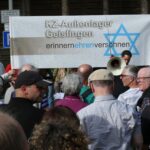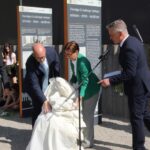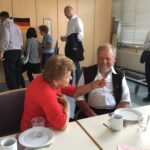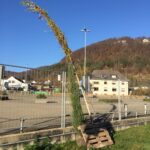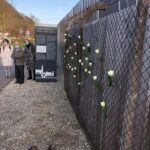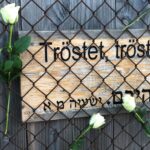
remembering
With rifles in their backs, 800 Jewish girls and women are driven through Geislingen every day.The concentration satellite camp Geislingen
Scene Geislingen, Eberhardstraße, February 1945, 5:30 pm. A large group of shaven-headed women in prisoners’ clothing, emaciated, exhausted, exploited, marches silently through the cold streets of the town. The ghostly procession is accompanied by armed SS men. The silence is broken only by the clatter of wooden shoes …
12-year-old girls gave their age as 16 and thus also came to Geislingen for forced labor. Here there was an own bed and personal eating utensils for each one and there was actually once a potato in the soup. Too little to live, too much to die.
Although WMF had requested men, the women were given a chance to show whether they could operate the heavy machines. The work performance was surprising. Afraid of being sent back to Auschwitz, the girls gave their all. But still, accidents happened again and again, fingers got under the heavy pressing machines and were severed. Screams echoed through the factory hall again and again. There was no medical care for such accidents. Even with fever and severe illness, the girls and women dragged themselves to work.

November 9 "Kristallnacht" in Goeppingen.
The action "Kristallnacht" was prepared with a long hand by the NSDAP, there can be no question of spontaneous "people's anger" as the NWZ and GZ report. The Goeppingen state archivist Karl-Heinz Rueß describes the events surrounding "Kristallnacht" in great detail. However, his account of the events, written in 1998, took 60 years to be published!
Rueß writes: "Kreisleiter Imanuel Baptist was called by the Gaupropagandaleitung in Stuttgart with the advice:" in the country the synagogues are burning, the rage of the people is inflamed." A precise order from the SA Ulm finally reached the Geislinger SA . The instruction demanded "that all synagogues be burned down immediately."
The Geislinger SA met in the inn "Kreuz" (opposite the town hall directly at the Rohrach), they drove to Goeppingen with two passenger cars and a truck, on which straw was loaded. One person even followed by bicycle. In front of the synagogue the troop was already expected by the SA-Sturmbannführer. District leader Baptist had the firemen's alarm line turned off. The SA men from Geislingen forced their way into the synagogue. There they set fire to the straw they had brought in with gasoline. The building burned out completely. The fire department was not allowed to go out to extinguish the fire. Their commander, Karl Keuler, was finally allowed to send out a platoon to prevent the fire from spreading to neighboring houses. 50-80 onlookers surrounded the fiery spectacle and accompanied it with anti-Semitic bawling. Because Keuler clearly voiced his displeasure that night, he soon had to resign from his position as fire department commander.
On the night of the pogrom, there was a second job to be done. This had come from the state police in Stuttgart. All male citizens of Jewish faith between the ages of 16 and 65 were to be arrested. They were rounded up at the Dettelbacher Hotel and in the following days transported to the Dachau concentration camp, where they were often mistreated during a prison stay of several weeks. When the men were picked up, apartments were also searched and the furnishings destroyed. At the Lendt department store on Untere Marktstraße, the shop windows were smashed and the displays looted….
The search for the perpetrators did not begin until the end of 1946, and was set in motion by the Goeppingen Federation of Trade Unions. In 1948, the indictment was presented to the Ulm Regional Court. Fifteen people were accused of breach of peace, joint arson and serious trespass. The district leader Immanuel Baptist received two years in prison.
Dr. Hansjuergen Goelz

Forced labor in Geislingen
From 1941 onwards, more than 2,000 forced laborers and prisoners of war, mainly from Eastern Europe, were deployed in Geislingen/Steige. Most of them worked at WMF, but many also worked in medium-sized companies, small businesses and in agriculture. The forced laborers were requested because the company's own employees had been drafted into the Wehrmacht. After the forced laborers were initially distributed throughout the city in various accommodations, a barracks camp was built in 1943/44 under the direction of WMF on a municipal site in Seebach on Heidenheimer Strasse. It is known that 83 forced laborers lost their lives in Geislingen.

Steps to the concentration camp satellite camp
In 1944, WMF, a metal processing company important to the war economy, requested additional labor. Since no more forced laborers could be assigned, WMF concluded a contract with the Natzweiler-Struthof concentration camp in Alsace to set up a satellite camp in Geislingen. In cooperation with the concentration camp, a camp section separated by a barbed wire fence was quickly erected on Heidenheimer Strasse with guard towers, camp guards, and SS guards. Starting in July 1944, a total of over 1,000 Jewish women and girls between the ages of 11 and 45 were housed in the concentration satellite camp. The prisoners came from Eastern Europe, mainly from Hungary, Czechoslovakia and Poland. They had previously been classified as "fit for work" at the Auschwitz death camp.
Living conditions in the concentration camp
The women worked in two 12-hour shifts under the supervision of factory employees. At shift change, the shaven-headed women had to walk from the camp to WMF and back through the city, accompanied by SS guards. The wooden shoes were part of the typical concentration camp prisoner clothing.
Malnutrition and cold frequently led to illness; there were at least 12 deaths among the prisoners in Geislingen. On several occasions, sick women who were not fit for work were sent back to the Auschwitz extermination camp. There is no trace of the fate of about 200 women and girls from the satellite camp.

The end of the concentration camp
In April 1945, the front was drawing ever closer. Since production at WMF had largely come to a standstill, the company management pushed to dissolve the concentration camp. Shortly before the liberation of Geislingen by the Americans, on April 11, the SS transported around 800 concentration camp prisoners away in freight cars in the direction of the Dachau/Allach concentration camp.
There they stayed for a few days. Afterwards, there was another selection and some of the women were shipped in freight cars towards Tyrol for a secret work assignment. The interrupted rail connections due to the effects of war ensured that the train was on the move for days in Bavaria. These women were liberated by American soldiers near Iffeldorf on April 29, 1945. Others experienced their liberation in Allach.
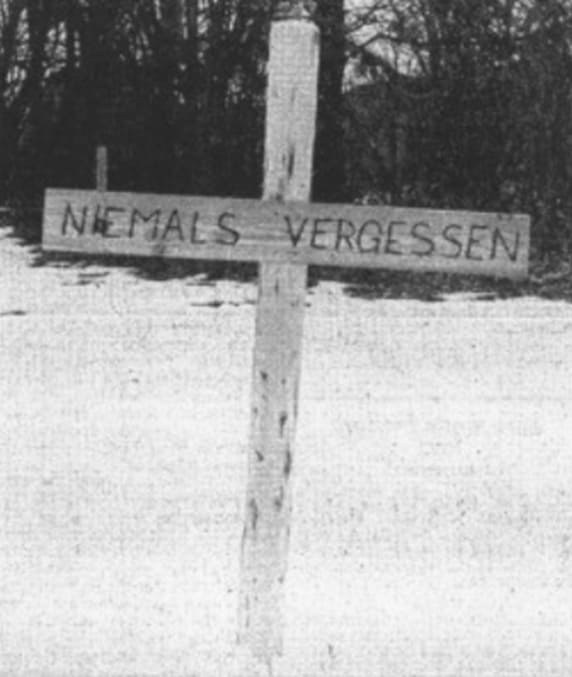
The debate about a memorial
The debate about a memorial for the Jewish girls and women of the former concentration camp Natzweiler-Struthof in Geislingen only began in 1983/84. A citizens' initiative was founded, which demanded an open confrontation with the National Socialist past and endeavored to come to terms with it. Their demands met with fierce criticism from the municipal council.

50 years after the end of the war
The 50th anniversary of the end of the war was taken as an opportunity in Geislingen to bring its own Nazi past back into the public eye. The exhibition "50 Years Later - Geislingen in the 3rd Reich" took place in the Museum im Alten Bau and a commemoration ceremony was organized by the town at the memorial "Wounded Head“.

With the help of the city of Geislingen and various other partners, the Evangelical Alliance organized an information evening about the concentration satellite camp in the city's Kapellmühlsaal in May 2014. City archivist Hartmut Gruber gave a lecture about the history of the camp. This event met with exceptionally great interest, quite a few listeners followed the lecture standing, as the Kapellmühlsaal was filled to capacity.

Great memorial event for the women of the concentration camp Geislingen
The Evangelical Alliance and other supporters conducted a silent march along the path from the former concentration satellite camp to Gate 1 of the WMF. At the subsequent event in the town hall, Mayor Frank Dehmer also welcomed former inmate Miryam Sobel and her children and children's children, as well as relatives of survivor Helen Jeckel. Miryam Sobel's granddaughter Sivan Sobel told her story. In addition, information boards of the city archive provided information about the concentration camp in text and pictures.
The stumbling block is laid in September
The Kulturwerkstatt der Raetsche e.V. organized the laying of the Stolperschwelle with Gunter Demnig in front of Gate 1 of the WMF in September 2015, and held a commemorative and lecture evening about the concentration satellite camp, with the names of all inmates known to date being read aloud to musical accompaniment. The traveling exhibition "Freedom - so near, so far" about the Natzweiler-Struthof concentration camp and its satellite camps could be viewed at the Geislingen town museum "Museum im Alten Bau". Information boards and exhibits of the Museum im Alten Bau and the town archive complemented the exhibition.
Name plaque in front of WMF
The WMF erected a memorial of names with the names of all survivors of the concentration camp - Geislingen who were listed on the transport list to Dachau on April 11, 1945.
Grave of Adolf Schoofs
Due to the visit of the former prisoner Helena Weksberg in Geislingen in November 2015, Adolf Schoofs came back into the public awareness, as it was a great concern for Helena to commemorate this "highly decent and honorable man". At his grave, she gave a speech of thanks for his humane behavior and his support of the girls during forced labor.
watch video about the memorial march

Construction of the memorial KZ - Geislingen
The memorial site KZ-Geislingen was inaugurated: Information boards - sponsored by the Verband der Region Stuttgart - and clogs cast in iron, as well as fence elements with barbed wire, are intended to enable remembrance with all senses. At the memorial ceremony at WMF, the Israeli ambassador to Finland and Estonia and descendant of two former prisoners, Dov Segev-Steinberg, reported on the fate of his relatives. Israeli Consul General Sandara Simovich from Munich also gave a speech.

Planting of the memorial site on November 9, 2020.
The initiative "remembering - honoring - reconciling" planted a mourning birch, a juniper and a white rose at the memorial site of the Geislingen satellite camp, which was erected in 2018, along the bicycle path behind the Odelo company.
These plants stand for the mourning of the victims, the life that nevertheless triumphs and shows itself in the many descendants of the survivors, and the memory that admonishes to "Never Again."
"Such signs against anti-Semitism are important," Matthias Lotz said in his speech, "because history still repeats itself." The year before, there had been an attack on the synagogue in Halle, and Jews living in Germany today often don't dare to wear a kippah in public. "We set up the memorial because we are FOR the Jews. That's more than just being against anti-Semitism," Lotz said.
As a sign of remembrance and in honor of all Jewish people murdered and suffering unspeakable torment during the Nazi era, 30 white roses were placed at the memorial.

Commemoration via Zoom April 2021
In the second year of the Corona pandemic, two survivors, descendants of other survivors, representatives of WMF and the city of Geislingen met with the initiative "remembering - honoring - reconciling" via Zoom to get to know each other and meet again. For the survivors it was a very emotional experience to tell their story in this setting. The children and grandchildren of the women who were imprisoned in the concentration camp Geislingen experienced this conference with happy and serious moments as very moving and are very interested in further meetings. As soon as traveling is possible again, they hope to meet in person in Geislingen and look forward to seeing each other again.




